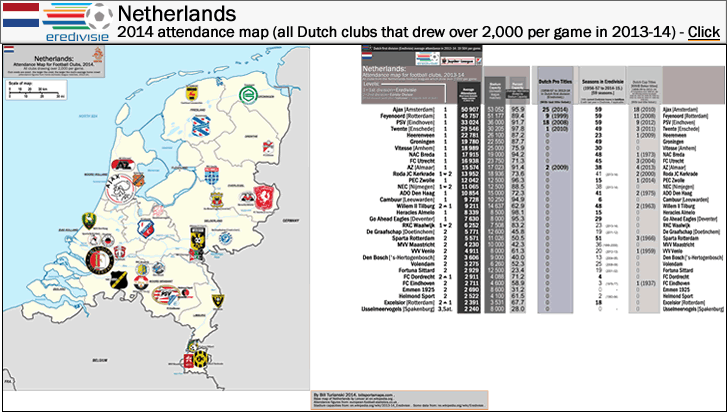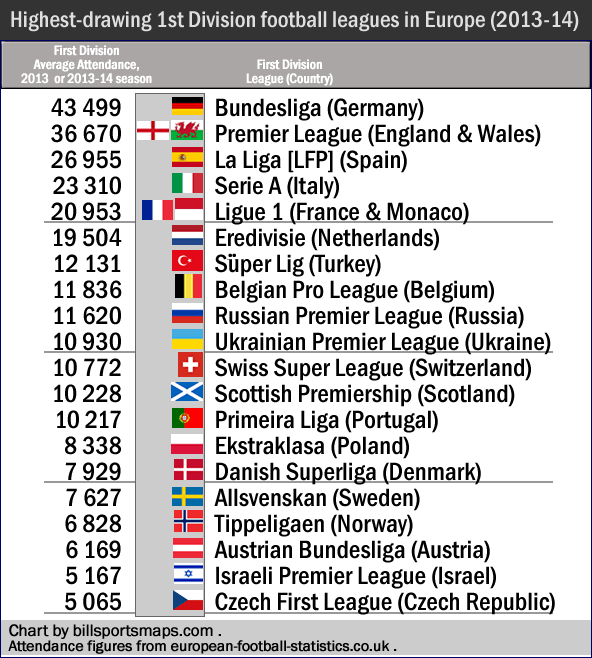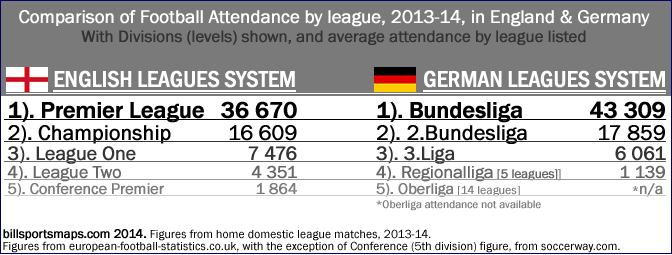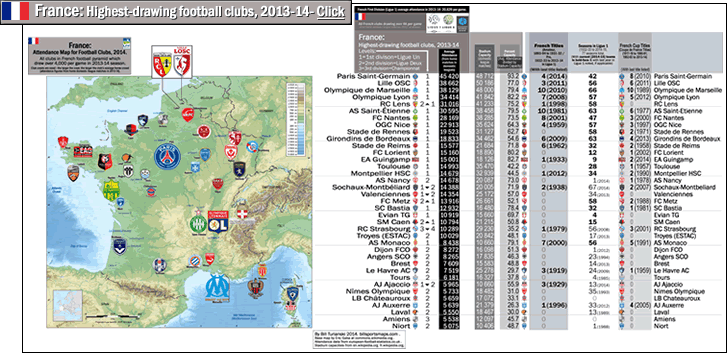
Spain: all clubs [36 clubs] that drew above 4 K per game in the 2013-14 La Liga and Segunda División seasons
…
…
Note: to see my latest post on Spanish football, click on the following, category: Spain.
…
[Please note: this map is different than the previous three 2013-14 attendance maps (of Germany, England, and France), all of which showed every club in those countries which drew over 4,000 per game. The problem here is that because reported 3rd division Spanish attendance figures do not exist, and because it is almost certain that clubs drawing above 4 K in the Spanish third division (Segunda B) do exist (such as for Racing Santander in 2013-14), I had to change the parameters of the map and chart for Spain. So the map shows all clubs that drew above 4 K per game in 2013-14 in Spain from the top two divisions (La Liga and Segunda División), plus...10 other clubs or teams in grey tone sans crests (but with locations shown). Those 10 extra included in grey-tone are... all the clubs that were in the Segunda División last season that didn't draw above 4 K per game (4 clubs as well as 2 teams - Barcelona's B team and Real Madrid's B team) plus the 4 four clubs that were promoted from the third division (Segunda B) to the second division (Albacete, Leganes, Llagostera and Racing Santander). One final point - one of these clubs just mentioned (and that drew below 4 K) is Eibar, who drew 3.0 K last year and won the Segunda División - thereby getting promoted to the Spanish first division for the first time {see below}.]
SD Eibar – the smallest-ever club to play in La Liga

Photo credits above – Town of Eibar seen from aerial view, by egoibarra.com. Interior photo of Ipurua with public housing in background, by Getty Images via the worldgame.sbs.com.au. Interior photo of 2 main stands at Ipurua with hills in background, by SD Eibar via stadionwelt.de. SD Eibar supporters with banners and flags, photo unattributed at el-punto-de-vista.com. Xabi Alonso photo as Eibar player in 2001, unattributed at wijzijnvoetbal.nl/forum/buitenland/48620-sd-eibar-1-baskische-bazen-op-weg-naar-de-primera-division.html.
[Note: Eibar is pronounced "A-bar".] SD Eibar, formed in 1940, are a small club from the Basque Country, in Eibar, Gipuzkoa province, in the steep and looming foothills of the Pyrenees in northern Spain. Eibar is located about equidistant from the two largest Basque cities in Spain – 49 km (30 mi) southeast of Bilbao and 56 km (35 mi) southwest of San Sebastian. The town of Eibar has a population of only around 27,000 {2010 figure). Sociedad Deportiva Eibar wear Barcelona’s colors and play in a 5,200-capacity stadium called Ipurua, and their fan base is about 2,500 or so (they drew 3.0 K in 2013-14). The club often relies strongly on loan players in general – often from the two biggest Basque clubs, Athletic Club [Bilbao] and Real Sociedad (of San Sebastian). Examples from the recent past include Spain national team members Xabi Alonso (of Real Madrid) and David Silva (of Manchester City), both of whom were sent by Real Sociedad to Eibar (14 years ago and 10 years ago, respectively) to toughen them up, early in their careers.
Eibar’s manager is the 39-year-old Bilbao-born Gaizka Garitano, who played in the midfield for Eibar for about 5 seasons total in two different spells (last in 2005), along with spells at all three of the biggest Basque football clubs (with Athletic Club for 111 league appearances from 1993-99; with Real Sociedad from 2005-08; and finishing his playing career with Alavés in 2008-09). Garitano took the reins at Eibar two years ago and has now led Eibar to back-to-back promotions.
Eibar has played 26 seasons in the second division, but had never won promotion to La Liga. Last season [2013-14], Eibar had just won promotion back to the second division, yet still had a higher wage bill than several clubs in Segunda División, including clubs that draw more than three-times-higher than Eibar, like Alavés and Hércules. Thus, Eibar gambled (successfully) on using a slew of somewhat expensive loan signings towards building a team that had a real chance of getting promotion – instead of having the approximately 1.7 million Euros in the bank that would have kept them safe from the stringent rules in place in the Spanish second division concerning fiscal solvency {see next paragraph and also see this article from May 2014 from the blog called El Punto de Vista, Let’s talk about SD Eibar}. As Neil Morris writes in the article at that link, “Much of [Eibar's] wage bill has been taken up by the loan fees of players from the top flight such as Berchiche, Eizmendi, Jota, Morales, Rivas and Garcia, and these deals have certainly helped them in their quest for promotion. The decision to keep a high wage bill seems to be a calculated gamble that has paid off with the ultimate prize.”…{end of excerpt from el-punto-de-vista.com/2014/05/28/lets-talk-about-sd-eibar by Neil Morris}.
The transition from the semi-pro third division to the pro second division is huge and often difficult in Spain because the clubs have to basically change their whole legal structure and become an S. A. D. {definition of S. A. D. in the following paragraph}, and then they have to have millions in the bank to fulfill the extremely stringent criteria. In the Spanish second division, as per a 1999 law intended to curb spending excess, each club must have cash on-hand (capital) equal to 25% of the average expenses of all sides in the second division (not counting the two clubs with the biggest outlays and the two with the smallest) – and in 2013-14, that amounted to about €1.7 million (or about $2.3 million). Last season, Jaén and Mirandés (both promoted to the Segunda División for 2013-14 along with [Basque sides] Alavés and Eibar) had similar problems in transitioning and navigating the red tape and the financial hurdles – Jaen got relegated back to the third (finishing second-to-last in 21st place) while Mirandés (finishing in 19th place) also would have been relegated right back to Segunda B had not the authorities banished Murcia instead on financial irregularities {see this from Marca on 8 August 2014, [article is in the Spanish but with a translation button to the English at the top left at the link], La LFP desciende al Murcia a 2ªB y asciende al Mirandés}. Last season, Eibar could very well have also went right back down to the third division if they remained within the spending rules throughout the whole season.
[Definition of S. A. D., from the Wikipedia page Sociedad Anónima Deportiva, {excerpt}... ..."Sociedad anónima deportiva ("Public limited sports company") is a special type of public limited company in Spain. The new legal status was introduced in 1990 to improve financial management and transparency in sports clubs. Many Spanish football and basketball clubs add the suffix S.A.D. to the end of their official name, e.g. Club Atlético de Madrid, S.A.D.. Every club which plays in Segunda División or [La Liga] and remains in the league is obliged to convert in S.A.D. Due to historical reasons Athletic Club, FC Barcelona, Real Madrid and Osasuna were allowed to retain their status as non-commercial sports associations.”…{end of excerpt}.]
Right when Eibar won the 2013-14 Segunda División in late May, there was talk that the authorities would block their promotion because of S. A. D. guidelines, and the following link is an article from that time period in the late spring of 2014 when it looked questionable for Eibar’s chances of being in the top flight (or the second tier for that matter). From 27 May 2014, from Guardian.com/football, from here is an article by Phil Ball, the author of the excellent book on Spanish football, Morbo…
Could Eibar’s astonishing rise to La Liga end before a ball is kicked? The smallest club to enter the top flight of Spanish football, described as a ‘model club’, could be demoted before the season starts due to ‘unfair’ regulations
A small club going up into the second tier, whether it is their first time in the second division or like Eibar in bouncing back up – will invariably find themselves forced to cut corners on player purchases just to remain within the Segunda División’s strict rules about fiscal solvency and the rules about becoming an S. A. D. (and their rule of literally having millions in the bank). One could make the case for the fact that had Eibar not gambled on success, a conservative and penny-pinching fiscal outlay resulting in a weaker squad would have just ended getting them relegated in 2013-14 the old fashioned way – via results on the pitch. If that is all true, I just love Eibar even more. For going for it. Well, via a limited share offering the club put together, football fans from all over (from 48 nations) plunked down cash to help Eibar’s cause, and the small club from hills of the Basque Country did raise the cash (the equivalent of $2.47 million was raised). From 16 June 2014, Eibar raises cash needed to play with the big boys (theworldgame.sbs.com.au via Omnisport).
From the New York Times, from 23 July 2014, by Raphael Minder, A Tiny Club’s Uneasy Rise – Eibar Is Facing Stiff Challenges in Spain’s La Liga.
From CNN, from 22 August 2014, by Chris Murphy and James Masters, Tiny Eibar take on Spanish soccer’s big guns Real Madrid and Barcelona (edition.cnn.com/sport/football).
I’ll leave the last word on this to Xabi Alonso, who with David Silva was instrumental in getting the world out that Eibar needed help from football fans the world over…to be allowed to play in La Liga this season. “It is contradictory that a club who has an enviable financial health and with zero debts is obliged to do this, when there are others who have much deeper problems.”…{quote by Xabi Alonso and can be found at the link third from above}.
…
Attendance problems, with lots of empty seats in Spain (plus billions of debt)
From Inside Spanish Football.com, from 5 March 2014, by Jen Evelyn, La Liga’s alarming attendance deficit demands actions (insidespanishfootball.com).
Attendance is down in Spain. As the article above touches on, the late start times (10pm) for some games and the lack of a definite schedule resulting in the switching of some game-dates and game-times – these things have not helped attendances in La Liga. Of course the economy is absolutely dreadful in Spain, but that has not actually eroded attendances since mid-2008 as much as one might have expected (see next paragraph).
Last season [2013-14] La Liga had a minus-1,282 per game average attendance drop or a 4.5 percent drop (26,995 per game in 2013-14, down from 28,237 in 2012-13). And in the season before, it was a 2 percent drop. If you are wondering about the lingering effects of the 2008 global economic downturn, well, in 2007-08, right before the market-crash, La Liga was averaging 29.1 K; and from 2008-09 to 2011-12 (4 seasons), league attendance stayed in the 28 K range, with it diminishing from 28.7 K average in 2011-12 to 28.2 K average in 2012-13. In other words, the slight-drop-off in crowds from the initial economic devastation in 2008 had already happened, and now in the last two seasons there is starting to be a bit of a steeper drop. From the Row Z Football blog, here is a graph from 2 years ago that shows what I was talking about in the last sentence, rowzfootball.files.wordpress.com/2013/06/european-football-attendance-chart.jpg; and here is a current chart showing attendance change in the Big 5 European leagues last season, European League Attendances 2013-14.
La Liga – playing to 125 thousand empty seats each week
And it is worse than it first appears because, as Ms. Evelyn points out in the article linked to 3 paragraphs above, the average La Liga stadium holds about 37,000, yet the league averaged about 27,000 per game in 2013-14…so La Liga clubs are playing to less than 75 percent capacity. Actually, it is even worse. I did the math {via these stadium capacity figures}, and the 20 La Liga stadiums in the 2013-14 season averaged a 39,531 capacity. So La Liga played to 68.2 percent capacity. That is really bad. That percent capacity figure of 68.2 is like what former-Premier-League clubs in England’s second and third division draw (such as Leeds (63.3) and Wolverhampton (65.8) /see this chart (Eng. 2014 attendances)).
Percent capacity that low is usually not the sign of a successful major league. 18 of 20 clubs in the Premier League in 2013-14 played to above 90 percent capacity (Sunderland [84.9 pct-cap) and Aston Villa [84.1 pct-cap] were lowest there); in the Bundesliga in 2013-14, 16 of the 18 clubs played to above 90 percent capacity (Nürnberg [80.8 pct-cap] and Hertha Berlin [69.8 pct-cap] were lowest there). In the Premier League, if even one or two clubs are playing to less than 75 percent capacity or so, it is news. Like when Wigan were in the top flight – that’s all you ever heard about in reference to Wigan. Here, in Spain, that sort of lack of drawing power among top tier clubs is becoming the norm. Three-quarters (16 clubs) of the Spanish first division played to crowds below 75 percent capacity. Just two clubs filled their stadium in the 80 percent range: Atlético Madrid played to 84.3 percent-capacity, and Real Madrid played to 83.7 percent-capacity. And exactly one club played to above 90 percent capacity – Athletic Club Bilbao…in their new stadium. So that is how bad it is with regards to attendances in Spain – Premier League: 18 of 20 clubs played to above 90 percent-capacity / Bundesliga: 16 of 18 clubs played to above 90 percent capacity / Spain: 1 of 20 clubs played to above 90 percent capacity…thanks to their brand new stadium.
A big reason why Real Madrid or Barcelona win the title 90 percent of the time
What is contributing to the malaise of Spanish football is the structural problem of allowing a certain couple of clubs (Real Madrid and Barcelona) to negotiate their own television deals, thereby insuring that the lions’ share of television revenue produced by Spanish first division football goes to just two clubs. Via their television deals, Real Madrid and Barcelona get over one hundred million Euros more per year than most of the other clubs in La Liga. The following link shows 2 pie-charts which reveal one of the primary causes of the pronounced duopoly in Spanish football. There are several reasons why Real Madrid and FC Barcelona dominate La Liga to such an extent, but in the modern game, uneven distribution of television revenue is at or near the top of the list of causes for this disparity. A disparity which, when combined with the huge crowds and thus the huge ticket revenue that the Big Two pull in (above 70 K per game for both clubs) is leaving the rest of Spanish football behind. Many of the other La Liga mainstays have gone into serious debt in the last decade trying to keep pace with Big Two, thanks to the disparity in television revenue between the Big Two and the rest. A disparity, which, when combined with the absolutely horrible economy in Spain, threatens the viability of first division Spanish football. From Imgur, ‘How TV money is shared in Spain and in England [2012 figures/illustration unattributed]‘ (imgur.com/vTZ9B5f).
Talk about an uneven playing field. And yes, I know that Atlético Madrid won the Spanish title last season. That doesn’t change the fact that Real Madrid and Barcelona have a grossly unfair advantage over all the rest, it just shows what a monumental achievement it was for Atlético Madrid, when the deck is stacked against every Spanish club besides the Big Two. And anyway, go look at that pie chart again and tell me who are the only other clubs besides Real Madrid and Barcelona to have bigger slices of the television revenue pie than the forgotten and hopeless rest-of-the-pack. That’s right…Valencia and current champions Atlético Madrid.
From El Centro Campista blog, from 6 August 2013, by Callum Nolan, La Liga’s haves and have nots (centrocampista.com).
Why are there no attendance figures reported for the 3rd division in Spain?
Spain might have a couple of the biggest football clubs in the world, but last season there were only 12 clubs in the whole country which drew above 20 K (meanwhile there were 27 clubs in England [& Wales] who drew above 20 K and there were 23 clubs in Germany who drew above 20 K). And in Spain, lower-league support is very thin. The Spanish football league system goes fully amateur below the third level, but it is not unknown for there to be amateur clubs in the semi-pro 3rd division. But they don’t even bother recording attendance figures in the regional third level in Spain, the 4 league/80 team Segunda División B. Elsewhere in Western Europe and in several places in Central Europe and in Eastern Europe, you can get attendance figures easily for the third divisions. Of course England has the most comprehensive reporting of lower league attendance figures…it is no problem getting attendance figures from the regional 6th level in England {like here}, and the 7th and most of the 8th level leagues in England produce readily available attendance figures {like here}. Germany produces attendance figures for all their lower leagues to at least the 5th level (which includes the semi-professional 4th level and the amateur 5th level there). Italy reports attendance for the top 4 divisions. France has attendance figures for its 3 top levels including their amateur 3rd division. Netherlands reports attendance for the top 2 levels (the pro levels there) there, as well as their amateur 3rd level (the Saturday and the Sunday leagues). And countries in Europe with pro leagues ranked far lower than Spain record attendance figures for their third divisions…Ukraine reports attendance for the top 3 tiers there, as does the Czech Republic, Sweden, Poland and even Denmark (including the 3rd tier in Denmark where over half the clubs are drawing below 350 per game). {Note: German and Italian and French and Dutch and Polish and Ukrainian and Czech and Swedish and Danish lower leagues attendance can be found at E-F-S site, here, among other places}. Here is the Spanish 3rd division official website, try finding attendance figures there (you won’t). I did not find attendance figures anywhere for the Spanish third tier, and a gentleman who helps run a Racing Santander web-forum confirmed to me what I had already figured out – they don’t exist (see thank you credits at the bottom of this post).
And what would be so shameful if attendances in Segunda B were revealed to be, outside of a few down-on-their luck mid-sized clubs, primarily within the 2 K to 3 K range, with several within the 500 to 1,000 range? If the figures were out there, at least you could talk about it. In this day and age, the status quo of absolutely no reporting of third division attendance in Spain looks more like a cover-up. A club of any size should not be ashamed of how low they are drawing at any one point in time (due to say, a relegation or two), to actively avoid announcing of their crowd sizes. A club that is a mainstay of any given league in any given level in any given country should not be ashamed of its attendance figures to actively avoid (and even repress) any reporting of it.
“It’s astounding how tolerant we all are to this corruption,” says Rubén Uría, a Spanish sports journalist with the Cope radio network and Eurosport.
{the quote above is from the article at the link below}
La Liga and by extension the Spanish football authorities act like a corrupt banana republic, with its special rules for its special friends. Special rules for the Big Two as seen in Real Madrid’s and Barcelona’s lucrative and separate-from-the-rest-of-the-league television deals. And special rules for the big boys – like the much more stringent and onerous financial rules for anyone entering into the second division compared to the spendthrift first division, where debts have reached the billions. And politicians, not actual bankers, running the banks that lend this crazy-cash to the profligate-spending clubs. As the article below points out, since 2006, half of the clubs in the top two divisions have entered bankruptcy proceedings, and by 2011-12, debts had reached €3.75 billion. From Newsweek, from 15 May 2014, by Mike Elkin, Spanish Soccer: World Champions (of Fraud) (newsweek.com). And smack dab in the middle of the most successful region of pro football in the world – Western Europe – the Spanish football authorities think it is perfectly acceptable to not even bother to report third division attendance figures. Meanwhile, judging by the alarming state of many first division clubs’ finances in Spain, it looks like more clubs and more clubs bigger than Alavés, Tenerife, Racing Santander, Hércules or Murcia will be finding themselves in (hopefully temporary) exile in the Twilight Zone of third division Spanish football. There in Segunda B, where few attend, and where the Spanish football authorities and the Spanish media never report attendances.
___
Thanks to NordNordWest, for the blank map of Spain, at ‘File:Spain location map.svg‘ (en.wikipedia.org). Thanks to Miguillen, for the blank map of the Canary Islands, at ‘File:Canarias-loc.svg‘ (en.wikipedia.org). Thanks to the contributors to the pages at La Liga and Segunda División (en.wikipedia.org and es.wikipedia.org and de.wikipedia.org).
Thanks to European-Football-Statistics site for attendance figures, http://www.european-football-statistics.co.uk/attn.htm.
Special thanks to Peña at RacinguistasOnline.com , who responded to my question of what he would estimate Racing Santander’s 2013-14 average attendance was, there in the Segunda B. He responded…” …At the beginning of the season, more or less 2.000-3.000 persons per game, more or less from february, with the expulsión of thieves, attendance grew up, more or less to 8.000 persons per game, although is very difficult to calculate, because there was games with almost full attendance (18.000) and other with 5.000… “…{end of excerpt from e-mail}. That sounded like about somewhere between 3.5 and 4.5 K per game to me.









